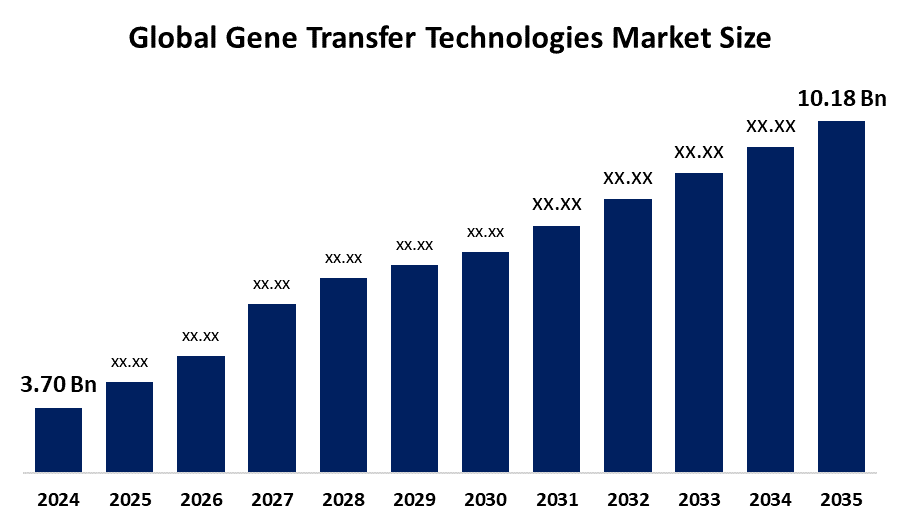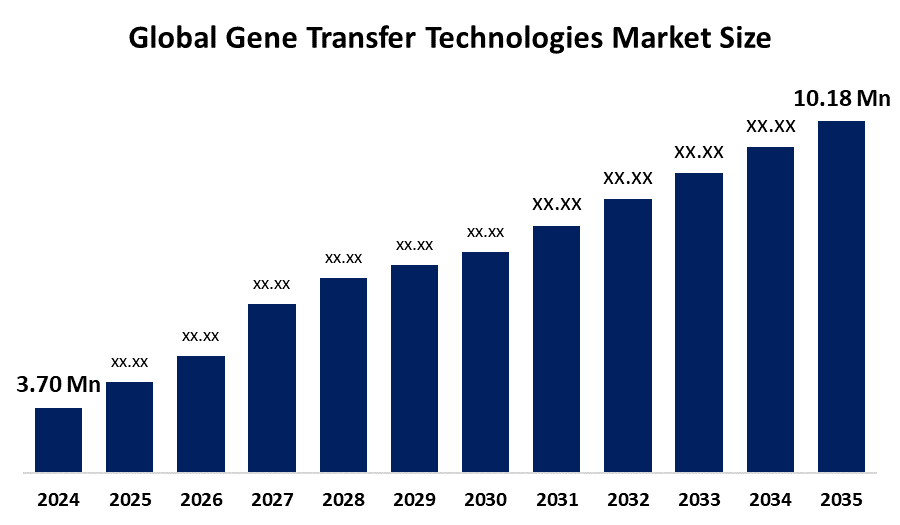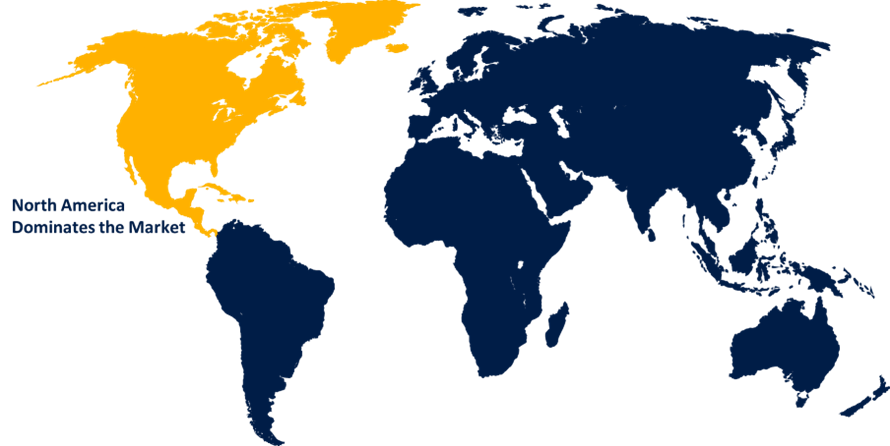Global Gene Transfer Technologies Market Size, Share, and COVID-19 Impact Analysis, By Product (Instruments, Kits, and Assays), By Mode (Viral (Retrovirus, Adenovirus, AAV), and Non-viral (Electroporation, Gene Gun)), By Application (Gene Therapy, Cell Therapy, Vaccines, and Research) and by Region (North America, Europe, Asia-Pacific, Latin America, Middle East, and Africa), Analysis and Forecast 2025 - 2035
Industry: HealthcareGlobal Gene Transfer Technologies Market Insights Forecasts to 2035
- The Global Gene Transfer Technologies Market Size Was Estimated at USD 3.70 Billion in 2024
- The Market Size is Expected to Grow at a CAGR of around 9.64% from 2025 to 2035
- The Worldwide Gene Transfer Technologies Market Size is Expected to Reach USD 10.18 Billion by 2035
- Asia Pacific is expected to grow the fastest during the forecast period.

Get more details on this report -
According to a research report published by Spherical Insights and Consulting, The Global Gene Transfer Technologies Market Size is expected to grow from USD 3.70 Billion in 2024 to USD 10.18 Billion by 2035, at a CAGR of 9.64% during the forecast period 2025-2035. The market for gene transfer technologies has several opportunities, such as growing investment in biotechnology research, expanding use in vaccine development, increasing need for novel cancer treatments, developing personalized medicine, and growing gene therapy applications.
Market Overview
The gene transfer technologies market encompasses the global industry involved in the development, production, and commercialization of technologies that enable the transfer of genetic material into cells. These technologies play a critical role in gene therapy, genetic engineering, and molecular biology research by facilitating the modification of cellular functions for therapeutic, diagnostic, and research purposes. The market growth for gene transfer technologies is being driven primarily by the increasing need for tailored medications, cell and gene therapies, and increased applications in vaccine development and cancer immunotherapy. One of the main factors propelling the market expansion for gene transfer technologies is the growing use in vaccine development and cancer immunotherapy applications.
Key Market Insights
- North America is expected to account for the largest share in the gene transfer technologies market during the forecast period.
- In terms of product, the kits & assays segment is projected to lead the gene transfer technologies market throughout the forecast period
- In terms of mode, the viral segment captured the largest portion of the market
- In terms of application, the gene therapy segment captured the largest portion of the market
Gene Transfer Technologies Market Trends
- Growing interest in cell and gene therapies and personalized medicine, particularly for cancer, chronic illnesses, and uncommon genetic abnormalities.
- Non-viral delivery techniques are becoming more and more popular as a way to lower immunogenicity and increase safety.
- Growing demand for in vivo delivery techniques due to the need for therapies that can enter the body directly, and advancements in vector technology.
- Substantial expansion of medicinal uses, as opposed to merely conducting more clinical trials and approving more products.
Report Coverage
This research report categorizes the gene transfer technologies market based on various segments and regions, forecasts revenue growth, and analyzes trends in each submarket. The report analyzes the key growth drivers, opportunities, and challenges influencing the gene transfer technologies market. Recent market developments and competitive strategies, such as expansion, type launch, development, partnership, merger, and acquisition, have been included to draw the competitive landscape in the market. The report strategically identifies and profiles the key market players and analyzes their core competencies in each sub-segment of the gene transfer technologies market.
Global Gene Transfer Technologies Market Report Coverage
| Report Coverage | Details |
|---|---|
| Base Year: | 2024 |
| Market Size in 2024: | USD 3.70 Billion |
| Forecast Period: | 2025-2035 |
| Forecast Period CAGR 2025-2035 : | 9.64% |
| 2035 Value Projection: | USD 10.18 Billion |
| Historical Data for: | 2020-2023 |
| No. of Pages: | 216 |
| Tables, Charts & Figures: | 130 |
| Segments covered: | By Product, By Mode, By Application |
| Companies covered:: | Lonza, Revvity, Qiagen, MaxCyte, Genscript, Bio-Techne, Sartorius AG, Merck KGaA, Takara Bio, Inc., Danaher Corporation, Promega Corporation, Oxford Biomedica plc, Bio-Rad Laboratories Inc., Agilent Technologies, Inc., Thermo Fisher Scientific Inc., Others, and |
| Pitfalls & Challenges: | Covid-19 Empact, Challenges, Growth, Analysis. |
Get more details on this report -
Driving factors
Gene transfer is a crucial differentiator as the need for more specialized, long-lasting treatments is driven by the rising incidence of neurological disorders, cancer, and genetic diseases. The need for improved gene transfer technologies is being indirectly increased by the FDA and EMA's progressive regulatory frameworks, which are speeding up the approval of gene therapy candidates. The increasing application of gene transfer technologies in cancer immunotherapy and vaccine development is one of the main factors in the gene transfer technologies market. Innovations in viral vectors and non-viral methods that provide flexibility, lower immunogenicity, and improved specificity are transforming the gene transfer technologies market.
Restraining Factor
High development costs, intricate manufacturing procedures, regulatory obstacles, delivery systems' limited scalability, and safety issues with immunogenicity and off-target genetic effects are the main factors restricting the gene transfer technologies market.
Market Segmentation
The global gene transfer technologies market is divided into product and application.
Global Gene Transfer Technologies Market, By Product:
- The kits & assays segment dominated the market in 2024 and is projected to grow at a substantial CAGR during the forecast period.
Based on product, the global gene transfer technologies market is segmented into instruments, consumables, reagents, kits & assays, and others. Among these, the kits & assays segment dominated the market in 2024 and is projected to grow at a substantial CAGR during the forecast period. The main factor driving the kits and assays market is the vital function these products play in expediting gene transfer procedures in a variety of clinical and research settings. Assays and kits offer standardized, easily navigable solutions that help researchers and doctors carry out intricate gene transfer processes more precisely and consistently.
The consumables segment in the gene transfer technologies market is expected to grow at the fastest CAGR over the forecast period. The growing need for highly specialized reagents needed for sophisticated gene editing methods, accurate assays, and improved analytical processes is fueling the reagents segment's expansion.
Global Gene Transfer Technologies Market, By Mode:
- The viral segment accounted for the largest share in 2024 and is anticipated to grow at a significant CAGR during the forecast period.
Based on mode, the global gene transfer technologies market is segmented into viral (retrovirus, adenovirus, AAV) and non-viral (electroporation, gene gun). Among these, the viral segment accounted for the largest share in 2024 and is anticipated to grow at a significant CAGR during the forecast period. The viral segment can be attributed to advancements in viral vector manufacturing, including automation and scalable production methods, as well as growing technological advancements for cell-based therapeutics. Adeno-associated viruses (AAV), lentiviruses, and retroviruses are increasingly being used for a variety of therapeutic purposes.
The non-viral segment in the gene transfer technologies market is expected to grow at the fastest CAGR over the forecast period. The benefits of increased safety, less immunogenicity, and expanding use in cutting-edge gene therapies and research applications are primarily drive the non-viral market.
Global Gene Transfer Technologies Market, By Application:
- The gene therapy segment accounted for the largest share in 2024 and is anticipated to grow at a significant CAGR during the forecast period.
Based on application, the global gene transfer technologies market is segmented into gene therapy, cell therapy, vaccines, and research. Among these, the gene therapy segment accounted for the largest share in 2024 and is anticipated to grow at a significant CAGR during the forecast period. The rising incidence of genetic illnesses and the rising number of gene therapy product approvals globally are the main factors driving the gene therapy market. The use of gene therapy has been further supported by developments in gene editing methods and improved delivery systems in a number of therapeutic domains, such as oncology, uncommon diseases, and hereditary disorders.

Get more details on this report -
The vaccines segment in the gene transfer technologies market is expected to grow at the fastest CAGR over the forecast period. The growing need for cutting-edge vaccination platforms, such as mRNA and DNA vaccines, which have shown great efficacy and adaptability in battling newly developing infectious illnesses, is driving the vaccines segment's expansion.
Regional Segment Analysis of the Global Gene Transfer Technologies Market
- North America (U.S., Canada, Mexico)
- Europe (Germany, France, U.K., Italy, Spain, Rest of Europe)
- Asia-Pacific (China, Japan, India, Rest of APAC)
- South America (Brazil and the Rest of South America)
- The Middle East and Africa (UAE, South Africa, Rest of MEA)
North America Gene Transfer Technologies Market Trends

Get more details on this report -
North America is expected to hold the largest share of the global gene transfer technologies market over the forecast period.
North America's market is further fueled by the existence of top businesses, rising genetic medicine funding, the rise in genetic illnesses, and developments in gene editing and viral vector technologies. The strong clinical trial infrastructures and regulatory efficiencies that enable quicker product approvals and commercialization are the main drivers of North America's supremacy in the larger gene therapy industry, where it maintained a 54% market share in 2024.
U.S Gene Transfer Technologies Market Trends
The market for gene transfer technologies in the United States is a significant and quickly expanding sector of the biotechnology industry, propelled by rising investments in gene therapy research, advantageous regulatory environments, and the high incidence of genetic illnesses. Strong government support, such as the National Institutes of Health's USD 481 million expenditure on gene therapy research in fiscal year 2025, as stated in official budget statements, is driving this trend.
Canada Gene Transfer Technologies Market Trends
The Canada market for gene transfer technologies is fueled by expanding demand for cutting-edge gene therapies, government support for innovation, and growing investments in biomedical research. Together with Genome Canada's $200 million Precision Health Initiative, the March 2025 federal investment in OmniaBio's AI-enabled facility supports the creation of genomic data for precision therapies, reducing the burden of chronic diseases in the face of demographic change.
Asia Pacific Gene Transfer Technologies Market Trends
Asia Pacific is expected to grow at the fastest CAGR in the gene transfer technologies market during the forecast period.
The pharmaceutical and biotechnology industries' growing investment and research funding to develop the healthcare sector is probably going to propel the region's market expansion. Increased government funding and investment in genomics research, the rise in chronic and hereditary disorders, the quick development of healthcare infrastructure, and strategic moves by leading market players have all contributed to the growth of the Next Generation Sequencing (NGS) and Gene Transfer Technologies (GTT) markets.
China Gene Transfer Technologies Market Trends
China's market for gene transfer technologies is bolstered by robust national biotechnology advancement goals and government initiatives. The first gene treatment for hemophilia B to be licensed in China is BBM-H901, and it is intended for individuals with moderate to severe hemophilia B. The commercialization of gene-based medicines and clinical studies has been expedited by significant public financing and advantageous regulatory modifications.
Japan Gene Transfer Technologies Market Trends
The market for gene transfer technologies in Japan is driven by government-supported programs and calculated expenditures on cutting-edge biomedical research. The Pharmaceuticals and Medical Devices Agency's regulatory accelerations, which have supported more than 50 continuing trials, mostly in oncology and genetic disorders, are reflected in this growth.
Competitive Analysis:
The report offers the appropriate analysis of the key organizations/companies involved within the global gene transfer technologies market, along with a comparative evaluation primarily based on their type of offering, business overviews, geographic presence, enterprise strategies, segment market share, and SWOT analysis. The report also provides an elaborate analysis focusing on the current news and developments of the companies, which includes type development, innovations, joint ventures, partnerships, mergers & acquisitions, strategic alliances, and others. This allows for the evaluation of the overall competition within the market.
Worldwide Top Key Players In The Gene Transfer Technologies Market Include
- Lonza
- Revvity
- Qiagen
- MaxCyte
- Genscript
- Bio-Techne
- Sartorius AG
- Merck KGaA
- Takara Bio, Inc.
- Danaher Corporation
- Promega Corporation
- Oxford Biomedica plc
- Bio-Rad Laboratories Inc.
- Agilent Technologies, Inc.
- Thermo Fisher Scientific Inc.
- Others
Key Target Audience
- Market Players
- Investors
- End-users
- Government Authorities
- Consulting And Research Firm
- Venture capitalists
- Value-Added Resellers (VARs)
Recent development
- In July 2025, A pioneering clinical-stage gene therapy company committed to transforming the treatment of neurodegenerative diseases, Myrtelle Inc. ("Myrtelle" or the "Company"), today announced the official start of commercial-stage manufacturing for its first-in-class oligotrophic recombinant adeno-associated virus (rAAV) gene therapy product, created especially for Canavan disease (CD).
- In September 2024, Cytiva launched its new RNA Delivery LNP Kit, expanding the GenVox-ILM product line. Designed for NanoAssemblr Ignite and Ignite+ systems, the kit accelerates mRNA and siRNA vaccine development, enhancing efficiency in lipid nanoparticle-based gene delivery workflows.
- In March 2024, Sartorius launched RPLUS, AAV-RC2, a Bercar plasmid specifically designed for adeno-associated virus vector 2 (AAV2) production. This launch expands Sartorius’ plasmid portfolio, supporting a broader range of AAV serotypes for advanced gene therapy applications.
Market Segment
This study forecasts revenue at the global, regional, and country levels from 2020 to 2035. Spherical Insights has segmented the gene transfer technologies market based on the following segments:
Global Gene Transfer Technologies Market, By Product
- Instruments
- Consumables
- Reagents
- Kits & Assays
- Others
Global Gene Transfer Technologies Market, By Mode
- Viral (Retrovirus, Adenovirus, AAV)
- Non-viral (Electroporation, Gene Gun)
Global Gene Transfer Technologies Market, By Application
- Gene Therapy
- Cell Therapy
- Vaccines
- Research
Global Gene Transfer Technologies Market, By Regional Analysis
- North America
- US
- Canada
- Mexico
- Europe
- Germany
- UK
- France
- Italy
- Spain
- Russia
- Rest of Europe
- Asia Pacific
- China
- Japan
- India
- South Korea
- Australia
- Rest of Asia Pacific
- South America
- Brazil
- Argentina
- Rest of South America
- Middle East & Africa
- UAE
- Saudi Arabia
- Qatar
- South Africa
- Rest of the Middle East & Africa
Frequently Asked Questions (FAQ)
-
1. What is the CAGR of the gene transfer technologies market over the forecast period?The global gene transfer technologies market is projected to expand at a CAGR of 9.64% during the forecast period.
-
2. What is the market size of the gene transfer technologies market?The global gene transfer technologies market size is expected to grow from USD 3.70 billion in 2024 to USD 10.18 billion by 2035, at a CAGR 9.64% of during the forecast period 2025-2035.
-
3. Which region holds the largest share of the gene transfer technologies market?North America is anticipated to hold the largest share of the gene transfer technologies market over the predicted timeframe.
-
4. Who are the top companies operating in the global gene transfer technologies market?Lonza, Revvity, Qiagen, MaxCyte, Genscript, Bio-Techne, Sartorius AG, Merck KGaA, Takara Bio, Inc., Danaher Corporation, Promega Corporation, Oxford Biomedica plc, Bio-Rad Laboratories Inc., Agilent Technologies, Inc., Thermo Fisher Scientific Inc., and others.
-
5. What factors are driving the growth of the gene transfer technologies market?The gene transfer technologies market growth is driven by advancements in delivery systems, rising demand for gene therapies, increasing genetic disorder prevalence, expanding research activities, and supportive regulatory frameworks.
-
6. What are market trends in the gene transfer technologies market?Key market trends include growing adoption of non-viral delivery systems, rising investments in personalized medicine, expanding applications in vaccines and cell therapies, technological innovations, and increasing public-private collaborations.
-
7. What are the main challenges restricting wider adoption of the gene transfer technologies market?Main challenges include high development and manufacturing costs, regulatory complexities, safety concerns such as immunogenicity, limited scalability, and ethical considerations hindering widespread adoption of gene transfer technologies.
Need help to buy this report?